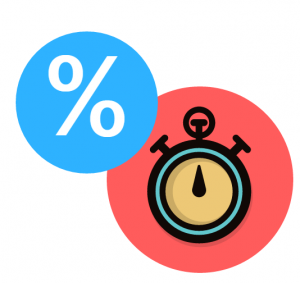What Are Interest Rates?
 Interest rates are growth rates – it is a percentage that is used to calculate how much a loan or investment grows over time.
Interest rates are growth rates – it is a percentage that is used to calculate how much a loan or investment grows over time.
Interest rates are most commonly associated with borrowing money, like a homeowner taking out a mortgage or a government selling a bond. The interest rate is how much extra needs to be paid back in exchange for the loan. Interest rates are also used in savings accounts, where you might earn interest on your savings.
For example, if you use your credit card to buy $100 with an 24% annual interest rate, if you wait one month to pay it back, you will need to pay back the $100, plus one month of interest (which is 24% divided by 12 months, or 2%). This means your final repayment would be $102.
Nominal VS Real Interest Rates
Interest rates are usually fixed, but a dollar today is not worth the same as a dollar a year from now. The interest rate you have on your loan or bond will not change over time and is called the Nominal Interest Rate, but the effective (or Real) interest rate is smaller if there is a lot of inflation.
For this reason, in economics we almost always use the Real Interest Rate. To calculate the Real Interest Rate, simply subtract the inflation rate from the Nominal Interest Rate.
This difference is very important for savers. For example, if you have a savings account that pays 2% annual interest (meaning a 2% nominal interest rate), but the inflation rate was 3%, your Real Interest Rate is -1% – you’re actually losing value!
This does not happen very often in the real world. The ability to use your cash has value, and by saving in a bank without withdrawing it, you are giving up that time value of money. Another way to put it is that you need to be compensated for deferring the use of that money from the present to the future. The interest rate exists to compensate you for that value that you lose. If people see that they are earning a zero, or negative, real interest rate in their savings accounts, most would withdraw that money and use it for other investments (like government bonds).
Using The Real Interest Rate
Using your real interest rate lets you calculate the Future Value of any investment or loan you make. Conversely, by using the inverse of the real interest rate, you can take any future value and convert it into the Present Value.
This means that you can use interest rates to effectively see how money travels through time. Saving is effectively fast-forwarding your money to the future for later consumption, while borrowing is effectively taking money from your future self for consumption now.
When you make a decision to save, you can use the real interest rate to see how much your savings will be worth in the future. If the future value of your savings makes it worth the wait, you will save. If not, you will consume today.
The same goes for when you borrow – if you decide that the present value of how much you need to pay back is less than you think it is worth, you’ll take the loan. If not, you would pass.
What Makes Interest Rates Increase or Decrease?
The real interest rate goes up and down over time, and varies quite a lot based on the investment and market as a whole.
Loan Risk
 If a loan is risky, the lender will charge a higher interest rate to compensate for the fact that they might not get paid back at all. On the other hand, very reliable borrowers usually have much lower interest rates.
If a loan is risky, the lender will charge a higher interest rate to compensate for the fact that they might not get paid back at all. On the other hand, very reliable borrowers usually have much lower interest rates.
This plays a big role with investments. Government bonds generally have extremely low interest rates because there is almost zero risk that it will default. Stocks, in contrast have a much larger potential rate of return, but their chance of losing value is also a lot greater.
Lots of Others Are Borrowing or Saving
Supply and Demand plays a role with interest rates too. If there are a lot of people trying to borrow, the interest rate goes up because the total amount of cash available to lend is limited. If lots of people are suddenly saving a lot more, the interest rates will start to fall, since there is less competition to borrow.
Expected Inflation
The expected rate of inflation also plays a major role on interest rates. Look at it this way – if you want to lend $100 to a friend to be paid back in one year, you would be a lot more interested in your real rate of return, which is based on inflation. If you think there will be a lot of inflation in the next year, you would increase the interest rate you’re asking to make sure your real rate of return keeps up.
What Do High Interest Rates Mean?
At the end of the day, when real interest rates are high across the economy, it means that a lot of people and businesses are borrowing money. This means that there is a general shift from saving to spending, and the allocation of resources over time has shifted from the future to the present (as a total economy, we are borrowing money from our future selves).
Higher interest rates mean that it is getting more expensive to borrow, which encourages people to save more, which starts to shift the balance of resources back to the future, and cause interest rates to fall in the long term.
In the short term, making it more expensive to borrow money means that people and businesses will be spending less on large purchases, like buying new equipment or a new house.
Having very high interest rates acts as a kind of “break” on the economy, slowing things down as people and businesses try to put off large purchases. This has a ripple effect through the economy. Rising interest rates are typically a result of economic growth, while falling interest rates are typically a symptom of an economic slowdown.
Pop Quiz
[qsm quiz=40]
